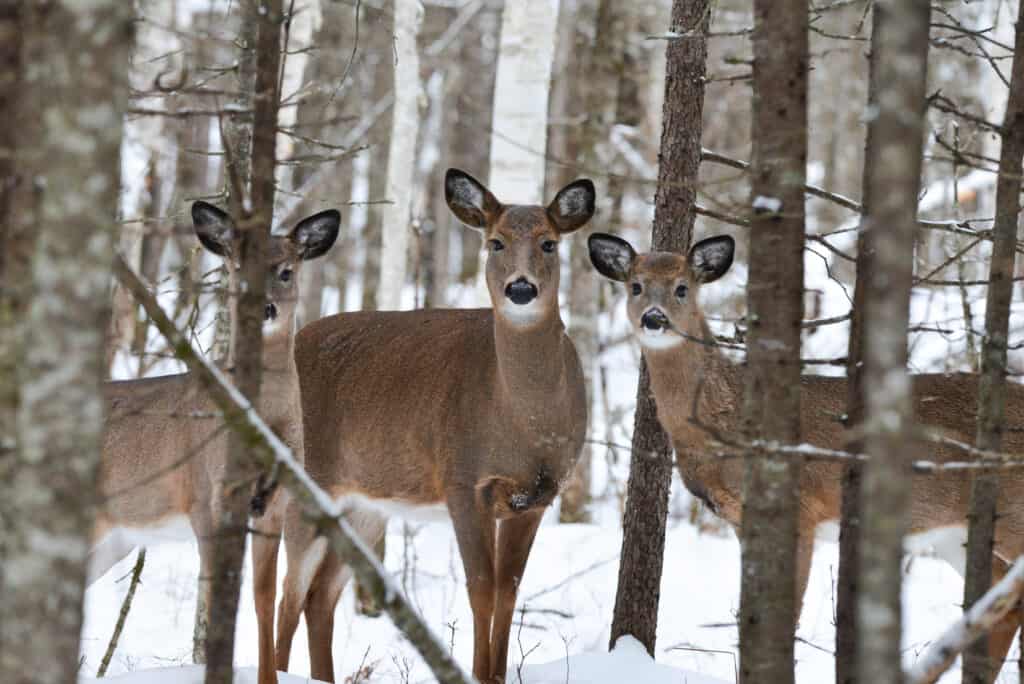The largest whitetail deer ever caught in Michigan was a monstrosity! An absolute unit, this colossal deer’s longevity at the top is longstanding! Let’s first dive into the characteristics of the whitetail deer.
Whitetail Deer Overview

The whitetail deer has white fur along its throat, around its eyes and nose, on its stomach, and the underside of its tail.
©Tom Reichner/Shutterstock.com
The whitetail deer is tan or brown in the summer and grayish brown in the late fall to winter. It sports flashes of white along its throat, around its eyes and nose, on its stomach, and on the underside of its tail. Male deer, called bucks, possess antlers. Bucks shed their antlers from mid-January to mid-April, but most mature bucks have shed their antlers by the end of February. Whitetails begin to grow their antlers back in the spring, in late March or early April. Female deer, known as does, do not have antlers. Males usually weigh between 150 and 300 pounds, and females weigh between 90 and 200 pounds.
Michigan’s Largest Whitetail: An Absolute Unit

Male deer, called bucks, possess antlers that are shed from mid-January to mid-April and are regrown each spring.
©Tom Reichner/Shutterstock.com
Troy Stephens took down the largest Boone and Crockett scored typical whitetail buck on November 26, 1996, in Jackson County. It scored 198 inches on Boone and Crockett’s scoring system, the standard in the industry. This monstrous buck ranks 40th overall among deer from all states. The buck has a total of 16 points — four of them abnormal. Its main beams are both over 29 inches, and its spread is 20 2/8 inches. This Michigan whitetail’s brow tines are enormous, measuring 10 and 11 3/8 inches, respectively. Its G2 is exceptional, as well, both extending below 13 inches. Stephens’s Michigan trophy deer record has lasted almost 27 years, an amazing feat in modern-day deer hunting!
Differences in Scoring Typical Versus Nontypical Whitetails

The whitetail deer is tan or brown in the summer and grayish brown in the late fall to winter.
©Rebecca C. Photography/Shutterstock.com
What is a nontypical whitetail deer? A typical or “normal” deer has antlers that have matching points in the usual locations on both sides with all points reaching up. Conversely, a nontypical buck has a nonmatching set of antlers, with a different number of points on each side. Points don’t necessarily lie straight up but will point in all directions.
The nontypical buck may have points growing off of other points, again different on each antler. What causes nontypical antlers? Part of the reason is a deer’s combination of genetics, age, and nutrition. Injuries play a big part in nontypical antlers. Because a deer’s antlers are 80% water, they are susceptible to injury. Sometimes, a deer will suffer an injury that renders his antlers nontypical for only a season. However, a significant injury can permanently make a deer’s antlers nontypical.
As far as scoring, choosing typical versus nontypical is up to the hunter and which option makes the most logical sense. Both methods measure abnormalities in the antlers based on their symmetry. The difference is that these abnormal points add to the score of a nontypical whereas they deduct from the gross score of a typical.
A whitetail’s antler symmetry is key for the net score because the scoring system values this balance. Basically, unless your deer has a bizarre amount of antler abnormalities, it’s best to score it as a typical whitetail deer.
Michigan’s Largest Nontypical Whitetail Deer

In Michigan, the deer hunting season is lengthy, ranging from October 1 to January 1.
©Kit Carlson/Shutterstock.com
Michigan’s largest nontypical whitetail deer has an interesting story. Usually, hunters harvest a buck and take him to a checking station to get weighed and processed. The hunter may also take the head and/or rack to a taxidermist to have it mounted. Michigan’s largest whitetail was not killed by a hunter. Rather, the largest buck recorded in Michigan died of natural causes at the end of the 2009 hunting season. Ron Waldron, from Ann Arbor, Michigan, was credited with this impressive nontypical whitetail.
A non-hunting friend of Waldron’s, Sharon Weidmayer, was walking her dog along a creek on her own property when she ran across an enormous whitetail rack. By this time, most of the deer’s carcass had been ravaged by coyotes, but Sharon knew it was a rare find. She then called her friend Ron Waldron to see if he wanted the rack. A hunter for over fifty years at the time, Waldron was astonished at the size of the Whitetail’s antlers. He was even more astonished when he found out just how big that buck really was: With a whopping score of 246 2/8, this mammoth buck had beams 31 inches long. The inside spread is 28 5/8 inches, and a few of the longest tines are between 12 and 13 inches in length.
The Elusive Michigan Nontypical Absolute Unit

A deer’s antlers are prized for their symmetry.
©Mega Pixel/Shutterstock.com
Deer hunting in Michigan is as ubiquitous as mosquitoes in August. In Michigan, the deer hunting season is lengthy, ranging from October 1 to January 1. What’s astounding is that few if any deer hunters saw this nontypical monster during hunting season. A 15-year-old girl saw and photographed the nontypical on July 11, 2009, a couple of months before hunting season. A few more hunters reported seeing the record-breaking deer after dark, but this giant whitetail’s story remains somewhat of an enigma.
Thank you for reading! Have some feedback for us? Contact the AZ Animals editorial team.








